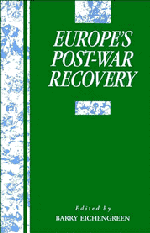Book contents
- Frontmatter
- Contents
- List of contributors
- Preface
- Part I Introduction and survey
- Part II The Marshall Plan
- Part III Other international initiatives
- 4 The IMF and the creation of the Bretton Woods System, 1944–58
- 5 The GATT's contribution to economic recovery in post-war Western Europe
- 6 The European Coal and Steel Community: an object lesson?
- 7 The European Payments Union: an efficient mechanism for rebuilding Europe's trade?
- Part IV Country studies
- Part V Synthesis
- Index
4 - The IMF and the creation of the Bretton Woods System, 1944–58
Published online by Cambridge University Press: 07 September 2010
- Frontmatter
- Contents
- List of contributors
- Preface
- Part I Introduction and survey
- Part II The Marshall Plan
- Part III Other international initiatives
- 4 The IMF and the creation of the Bretton Woods System, 1944–58
- 5 The GATT's contribution to economic recovery in post-war Western Europe
- 6 The European Coal and Steel Community: an object lesson?
- 7 The European Payments Union: an efficient mechanism for rebuilding Europe's trade?
- Part IV Country studies
- Part V Synthesis
- Index
Summary
Faced with a task of immense complexity, we often search for historical parallels. Currently, two contrasting approaches are offered to the problem of economic reform in East European and former Soviet republics and their integration into the world economy. On the one hand, there is full and rapid international integration (with multilateral trading practices and immediate currency convertibility), on the other, a regional approach (with regional trade preferences, and non-convertible currencies grouped in a clearing union).
In arguments against sudden “big bang” transitions to full convertibility, the example of post-war Europe is frequently cited (see the discussion of Polak, 1991; van Brabant, 1991; Williamson, 1991). European states did not return to convertibility on current account transactions until after 1958, thirteen years following the end of World War II. Yet they provided the most convincing example in all of economic history of an “economic miracle.” Do they in fact give a historical argument against quick convertibility?
While advocates of the multilateral approach emphasized Bretton Woods and the Marshall Plan, the regionalist approach saw the European Payments Union as the key institution in the international restructuring of Western Europe. Alan Milward (1984) examined the development of trade policy and argued that the drive to European integration came not so much from American pressures or from the European Recovery Program (Marshall Plan) but from French, Belgian, and German calculations of national interest.
- Type
- Chapter
- Information
- Europe's Postwar Recovery , pp. 93 - 126Publisher: Cambridge University PressPrint publication year: 1995
- 5
- Cited by



